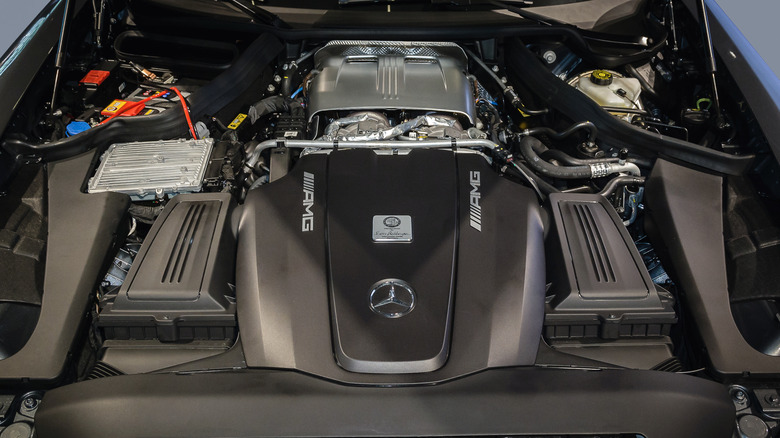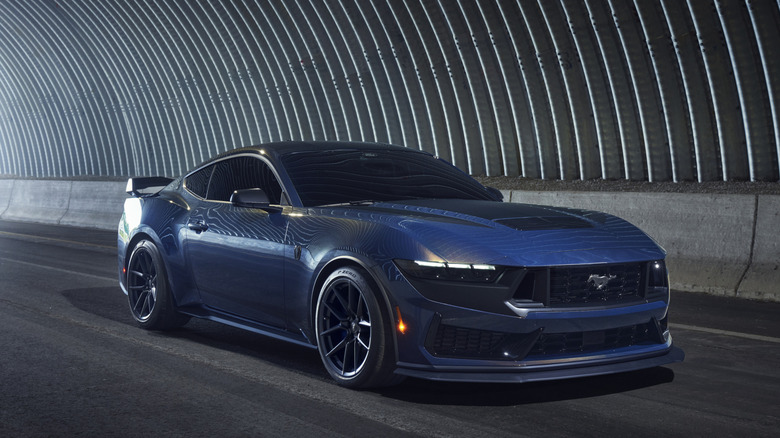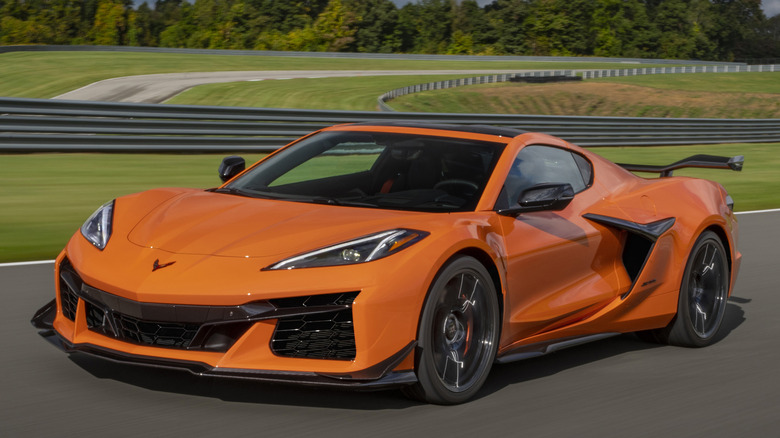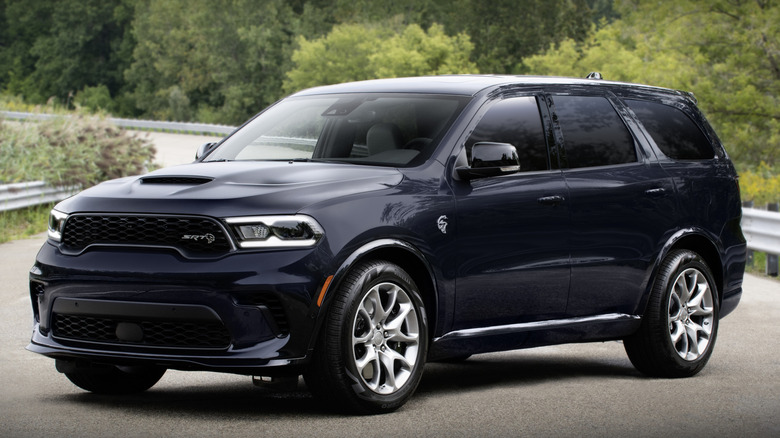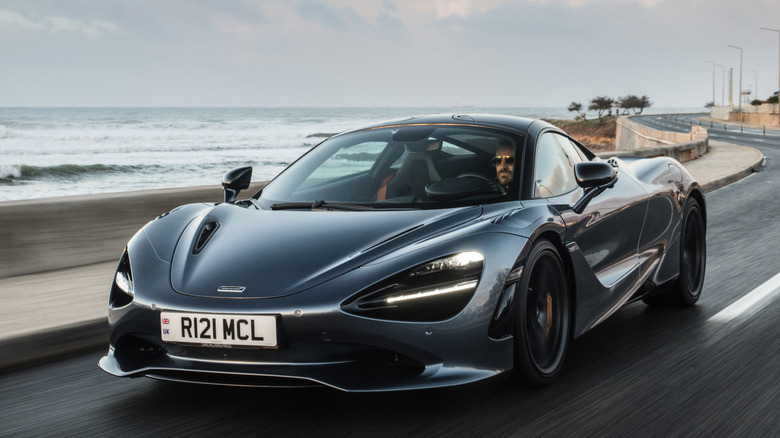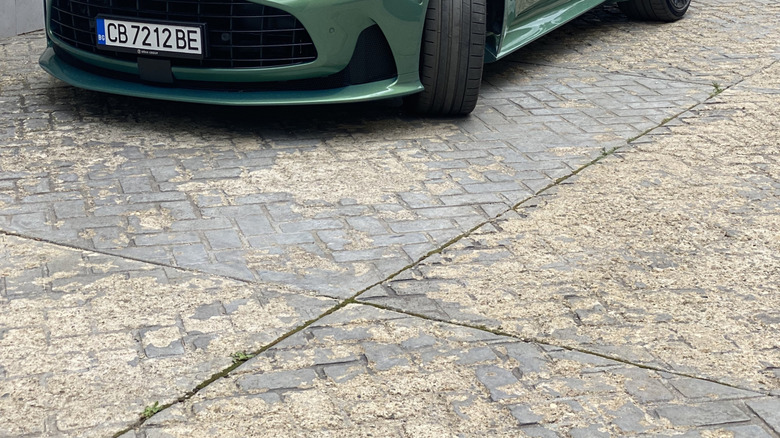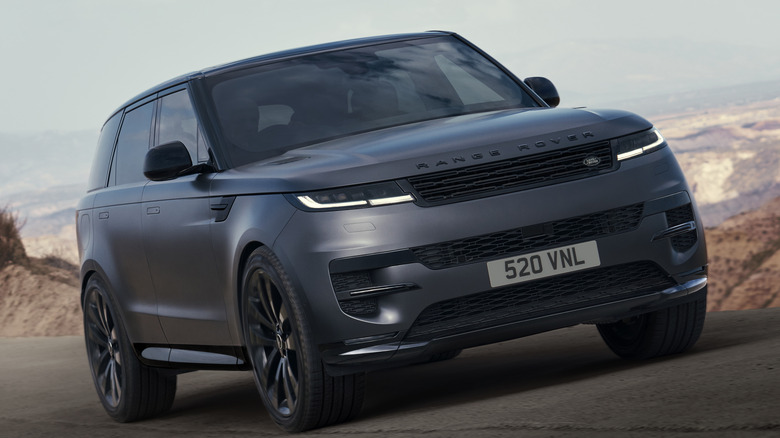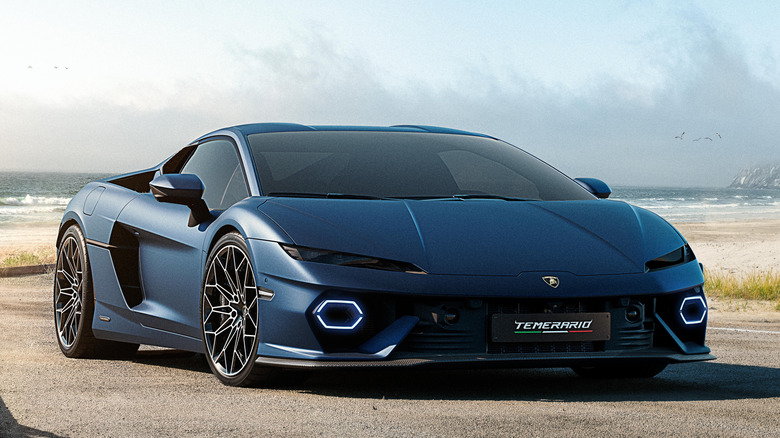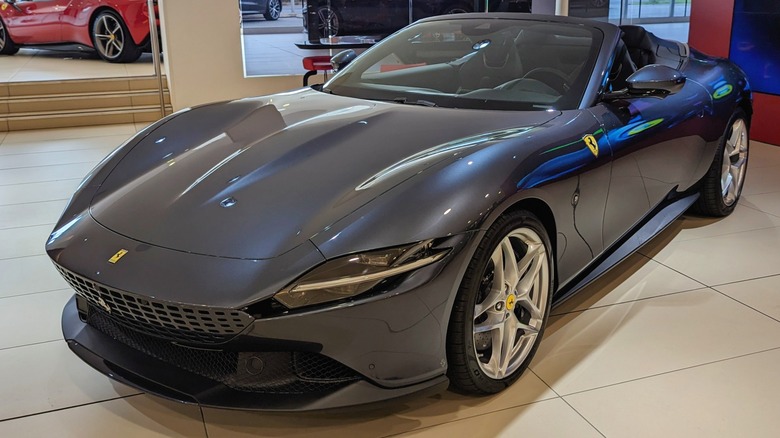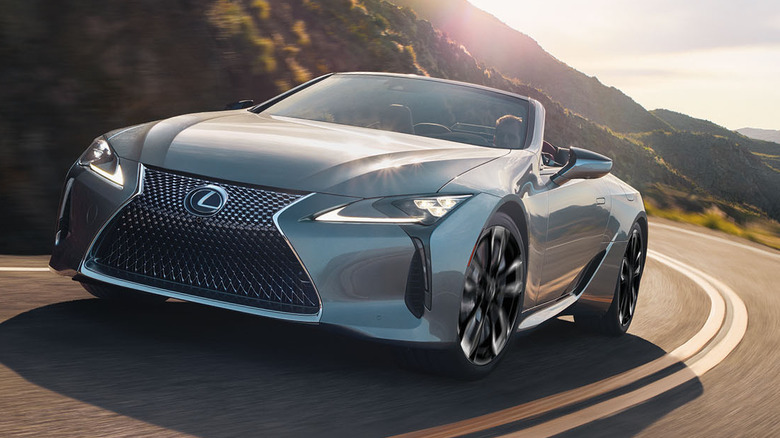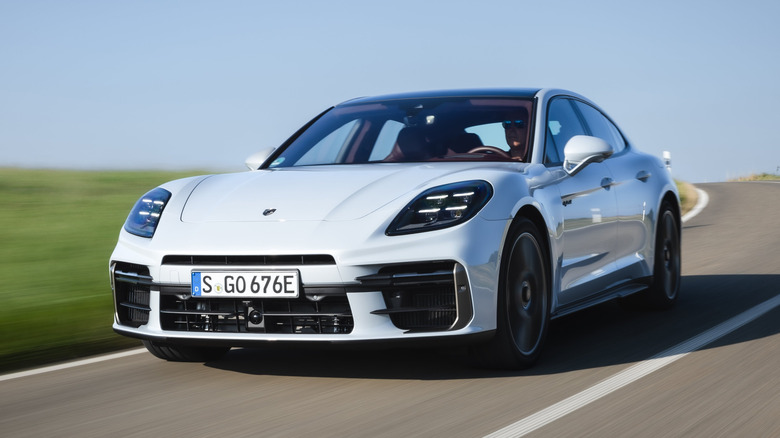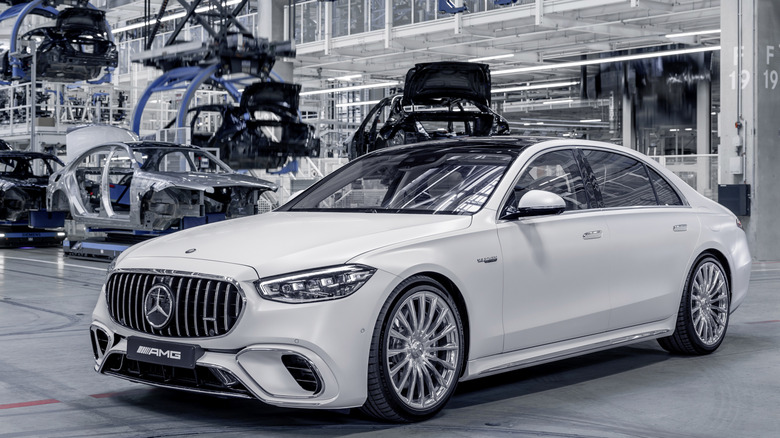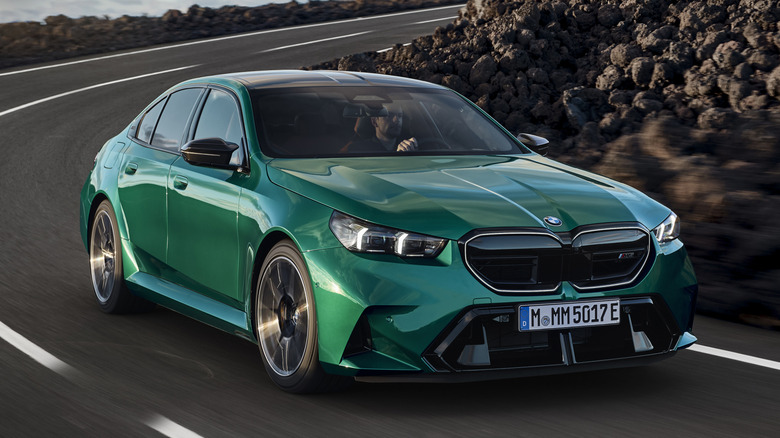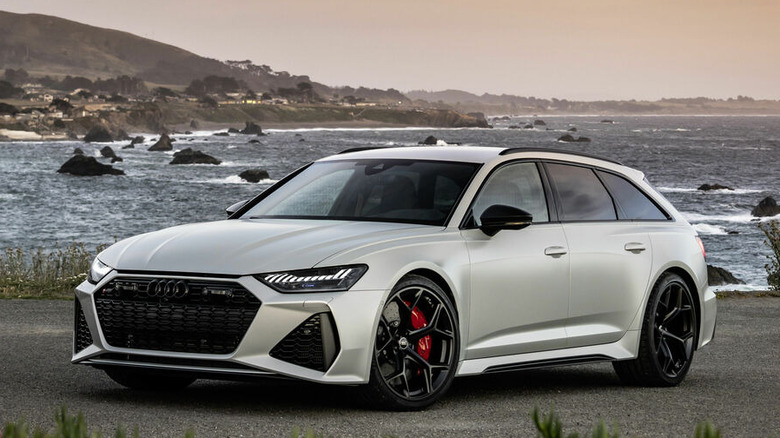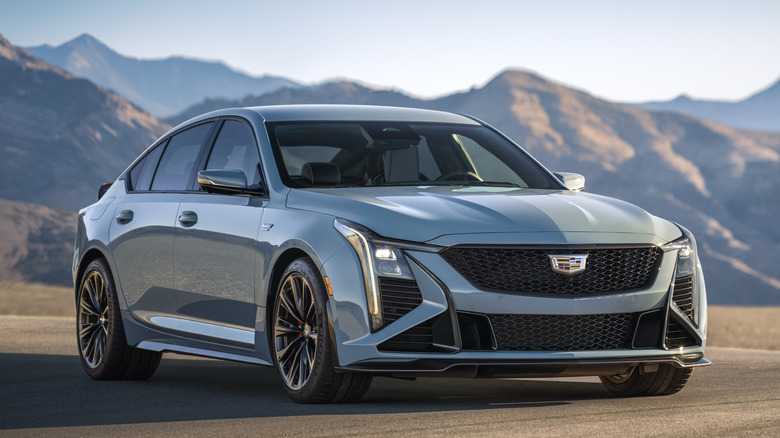Every Car Brand That Still Sells A V8 In 2025
The V8 engine is in an interesting place at the moment. Sure, HEMI-powered muscle cars are becoming a thing of the past, but that doesn't mean the V8 is dead. Ford and Chevy are sticking to their guns with pure gasoline V8s in their performance cars, while automakers like Lamborghini and Aston Martin are pushing the envelope with hybridized V8s that put out staggering amounts of power.
So, really, rumors of the V8's demise are perhaps somewhat exaggerated. Even the HEMI is alive and well in Dodge's Durango and the Ram trucks. The landscape may not be quite the same as it was in the V8's heyday, sure, but the future still looks quite rosy for fans of eight-cylinder power. Well, provided they have deep enough pockets. Many of the brands we'll discuss here don't exactly make cheap cars, but that seems to be the price you'll have to pay for that signature V8 burble.
A quick note before we begin. This list focuses on mass-production automakers — the Fords, Chevrolets, and BMWs of the world — and not ultra-limited hypercar builders like SSC or Hennessey, some of which still use V8s in their cars.
Ford
Let's kick things off with probably one of the most predictable names on this list: Ford. Unlike Dodge and its 2025 Dodge Charger Daytona, Ford has stuck with traditional V8 power for its signature muscle car, the Mustang. As with almost every Mustang since the launch of the first generation in 1964, the modern-day Ford Mustang is available with V8 power under the hood.
Ford currently sells two versions of the Mustang: the EcoBoost and the GT. The former has a four-cylinder EcoBoost engine under the hood, while the latter packs Ford's 5.0-liter Coyote V8. The V8 makes 480 horsepower and 415 lb-ft of torque, climbing to 486 and 418, respectively, with the active exhaust and premium gasoline. Would-be Mustang owners who want even more grunt can step up to the Mustang Dark Horse, which squeezes 500 horsepower out of the same engine.
Ford's trucks also use V8 engines, with higher-end trims of its ever-popular F-150 sporting eight-cylinder engines. The F-150 Tremor has a 5.0-liter V8 making 400 horsepower and 410 lb-ft of torque, while the Raptor R is available with a supercharged 5.2-liter V8 that puts out an impressive 720 horsepower.
Chevrolet / GMC
Ford isn't the only automaker out of Detroit still building V8-powered performance cars. General Motors (GM) is also still at it, with the current mid-engined Corvette C8 still getting its propulsion from an old-school V8. From the entry-level Chevrolet Corvette Stingray to the bonkers 1,000-horsepower Corvette ZR1, Chevy's supercar killer continues flying the flag for V8 power — even if the latter's flat-plane V8 is a bit of a departure from the more common cross-plane V8s.
The V8 engine is also featured in Chevy's truck and SUV offerings, such as the Silverado. Certain trim levels of the Silverado 1500, like the LTZ and High Country, come with GM's 5.3-liter EcoTec3 V8 as standard and can be optioned with a larger 6.2-liter EcoTec3 V8. Silverado 2500 HD models, on the other hand, come with GM's 6.6-liter V8. Most models of the 2025 Chevrolet Suburban have the same 5.3-liter EcoTec3 engine and can be optioned with the larger version if needed. The only exception is the Suburban High Country, which has the latter from the factory.
Fellow GM brand GMC also sells a few V8-powered vehicles, with products like the Sierra 1500 having V8s like its close Chevy counterparts. The lower trim levels of the Sierra have optional 5.3-liter V8s, with the first factory-equipped V8 coming in the $55,000 Sierra SLT.
Dodge / Ram
Dodge caused quite a stir when it announced it would discontinue its legendary HEMI engine, replacing it in its muscle cars with V6s and electric motors. But the months since the announcement have shown that the company isn't quite ready to give up on the HEMI completely.
While there's no indication that Dodge will bring the iconic name back to its performance cars, prospective buyers who want some HEMI power can get it with the company's Durango SUV. The 2025 Dodge Durango R/T has Dodge's 360-horsepower, 5.7-liter HEMI V8 under the hood, while the Durango SRT Hellcat takes things a whole lot further with a supercharged 6.2-liter HEMI producing 710 horsepower and 645 lb-ft of torque — making it one of the most powerful SUVs money can buy. Rumors indicate that the HEMI is sticking around for 2026, too, so it looks like HEMI fans aren't out of luck just yet.
Advocates of the V8 have slightly more choice if they're interested in pickups, though. The modern Ram 2500 and 3500 pickups come with 6.4-liter HEMIs that make 405 horsepower and 429 lb-ft of torque.
McLaren
Let's go from the utilitarian to the exotic and turn our gaze to McLaren, the maker of legendary cars like the McLaren F1 and its spiritual successor, the recently-announced McLaren W1. The W1 hypercar, coincidentally, is one example of the company's V8-powered offerings, with an all-new MHP-8 V8 engine paired with electric drive for a total power output of 1,275 horsepower. Zero to 60 mph times are expected to be well under 3 seconds, and McLaren estimates that the W1 will hit 124 mph in just 5.8 seconds.
That sort of performance won't come cheap, of course. The W1 starts at $2.1 million, making it unattainable for all but the most well-off petrolheads. However, those who want V8-powered McLaren action have more options in the form of the touring-focused McLaren GTS and surprisingly accessible 750S sports car. Both of these have twin-turbo, 4.0-liter V8s and are just that little bit more attainable than the W1 — although we're sure that the $300,000-plus MSRP of the latter is still out of the reach of most. Both have the same twin-turbo V8 configuration, but the 750S makes 740 horsepower while the GTS can achieve 626.
Aston Martin
McLaren isn't the only high-performance British carmaker with V8 engines in its stable. Aston Martin is also still very much in love with the V8, featuring the classic eight-cylinder setup in several of its current cars. The most eye-catching of them all is probably the Aston Martin Valhalla, which uses a tweaked version of Mercedes-AMG's 4.0-liter, twin-turbo M178 LS2 engine that makes 817 horsepower. That alone would be enough to make it one of the most powerful V8s ever, but Aston Martin ups the ante with twin electric motors on the Valhalla for a total output of 1,064 horsepower and 811 lb-ft of torque.
Like McLaren, Aston Martin has a few more V8-powered vehicles that come in at somewhat more affordable prices — comparatively speaking, of course. Examples include the 2025 Aston Martin DB12, which marries grand tourer refinement with a twin-turbo, 4.0-liter V8 making 671 horsepower and 590 lb-ft of torque. Well-off owners who want a prestige take on powerful SUVs like the Dodge Durango Hellcat can also opt for the Aston Martin DBX707, which is a V8-powered mega-SUV that makes 697 horsepower and 590 lb-ft of torque.
Land Rover
We like the Aston Martin DBX707 here at SlashGear, but it's far from the only option if you're after a premium, V8-powered SUV. The most obvious alternative option if you want to stick to British brands is Land Rover and its Range Rover SUVs, which can be had with mild-hybrid V8s for those who want a good chunk of power — be it for off-roading or to do the school run.
The Land Rover Range Rover is available in a few configurations, including the six-cylinder P400. Those seeking V8 power will have to step up to the Range Rover P530, which comes with a 4.4-liter twin-turbo V8 producing 523 horsepower — and which is also available in seven-seater configuration for some high-powered people-carrier hijinks. But that's not the most potent offering in Land Rover's arsenal. For that, we turn to the Range Rover SV, which cranks the hybrid power to a maximum of 626 horsepower and 553 lb-ft of torque in the Ranger Rover Sport SV.
Bentley
The final British automaker on this list is Volkswagen-owned Bentley, which still has a few V8s in its lineup as of 2025. While the marque may be better known for extravagant engines like the Bentley W12, the humble V8 plays a significant role in the marque's current automotive program. Its current offerings all use V8s in either pure gasoline or hybrid configurations.
Bentley's Bentayga SUV may have debuted with the W12 back in 2016, but the end of W12 production in 2024 means that the SUV now has to slum it with a petrol V8 or hybrid V6. Not that the former is anything to be ashamed of, mind you, with its 542 horsepower and 510 lb-ft of torque good enough for a 3.5-second zero to 60 mph time.
The current Flying Spur and Continental GT also have V8 engines, although these opt for plug-in hybrid powertrains instead of the Bentayga's pure gasoline V8. Both make 771 horsepower and 738 lb-ft of torque from their combination electric motor and 4.0-liter turbocharged V8s.
Lamborghini
Land Rover and Aston Martin's V8 SUVs are certainly potent examples of the breed, but nothing quite matches Lamborghini for sheer V8 SUV craziness in our book. The Urus, available in three variants — the S, SE, and Performante — is all V8, with the S and Performante featuring the same 656-horsepower, 4.0-liter turbocharged V8 that's powerful enough to take both to 60 mph in well under four seconds. The Urus SE brings that up to 788 horsepower and 701 lb-ft of torque courtesy of an electric motor — making for quite an exciting SUV, as we discovered during a test drive.
Lamborghini has also gone with hybrid V8 power for the Lamborghini Temerario, its successor to the popular Huracán. The Temerario's V8 is on a whole other level, though, with the 4.0-liter V8 making 789 horsepower on its own — aided, no doubt, by the 20.3 psi of boost from its twin turbos. As you might expect for a modern-day supercar, though, the Temerario's V8 has company in the form of three electric motors. The result is unsurprisingly impressive: 907 horsepower and 590 lb-ft of torque, enough for a claimed zero to 62 mph time of just 2.7 seconds.
Ferrari
Lamborghini's long-time rival Ferrari is no stranger to the V8 engine either, with V8-engined models going all the way back to the heady days of the Ferrari 308. Those days are long gone, of course, but the Prancing Horse has kept the eight-cylinder dream alive — even if its current stable only has one V8 model still in active production as of early 2025.
That model is the Ferrari Roma Spider, which uses a version of Ferrari's modular F154 V8 that first debuted in the Maserati Quattroporte in 2013 before entering service in the Ferrari California T the following year. It uses a 3.9-liter displacement version of the original, but the grand touring drop top's engine makes 612 horsepower and 561 lb-ft of torque compared to the California T's 560 horsepower.
Ferrari is currently down to just one V8 car after the automaker phased out the Roma Coupé and plug-in hybrid SF90 Stradale. That may not be for long, though, as it has been testing successors to both — with commentators expecting the former to retain a V8 under the hood.
Lexus
There are a lot more European carmakers that will still sell you a V8, but let's take a bit of a detour for a moment and turn our attention to Lexus, which is, to our knowledge, the only Japanese brand that continues putting V8s in its cars. But the current Lexus V8 isn't the old-school, low-power V8 in cars like the Lexus LS 400 and Toyota Crown Majesta. Instead, it makes nearly 500 horsepower and is the beating heart of its performance coupes and sports sedans.
The Lexus IS 500 sedan, LC 500 sport coupe, and RC F — the latter of which is bowing out after 2025 — all have the same 5.0-liter V8 under the hood. More specifically, it's the 2UR-GSE V8, one of the few naturally aspirated V8s on our list and one of the most powerful engines to ever feature in a Lexus. The much-admired engine makes 471 horsepower and 395 lb-ft of torque in all three cars, making for zero to 60 times in the low-to-mid four-second range.
Porsche
Porsche isn't a name most would associate with V8s, having stuck to six-cylinder engines across all generations of its flagship Porsche 911 and derivatives such as the Boxster (at least until the introduction of the flat-four 718 Boxster in 2016). Despite that, the German marque has dabbled in V8s over its long history and currently boasts two V8 models in the Cayenne and Panamera, in both ICE-only and hybrid implementations.
The Cayenne S, Cayenne GTS, and the Panamera GTS represent Porsche's gasoline V8 contingent. All four have a twin-turbocharged 4.0-liter under the hood. The Cayenne S is the least powerful, with 468 horsepower and 442 lb-ft, while the Cayenne GTS and Panamera GTS both make 493 horsepower and 486 lb-ft of torque.
Those who want more power will have to accept some electrification. The Panamera Turbo E-Hybrid pairs a 512-horsepower version of the V8 with an electric motor to make 671 horsepower and 686 lb-ft of torque. The Cayenne Turbo E-Hybrid is even beefier with 729 horsepower and 700 lb-ft of torque, but the big daddy is the Panamera Turbo S E-Hybrid, which makes a total of 771 horsepower.
Mercedes-Benz
In a strange twist of fate, it seems like German automakers are the ones most visibly flying the flag for the V8 as a performance engine. Mercedes-Benz is a great example, with its AMG sub-brand building V8s for Aston Martin's performance cars and continuing to offer hand-built V8s in most of its products.
Not that Mercedes-AMG models are the only V8-powered offerings in the Mercedes-Benz product lineup, though. Non-AMG vehicles like the Mercedes-Benz GLS 580 4Matic and Mercedes-Maybach S 580 4Matic have mild-hybrid V8s good for around 500 horsepower. That's probably enough for most, but those who want more can step up to AMG-branded products like the Mercedes-AMG S63 E Performance. The AMG adds an electric motor to push the hand-built twin-turbo V8's output to 791 horsepower and a frankly ludicrous 1,055 lb-ft of torque.
Mercedes-AMG's V8 offerings look to be expanding soon, too, with the 2026 CLE 63 set to feature a V8 under the hood (via CarScoops). Rumors indicate that the upcoming C-Class will also receive some form of V8 engine, showing that the eight-cylinder layout isn't quite as dead as we thought.
BMW
BMW isn't far behind Mercedes when it comes to its commitment to V8 engines, with the Bavarian marque similarly opting to go for hybridized V8s in its high-performance vehicles like the 2025 BMW M5. The current M5 — the latest in a line that stretches back an impressive 40 years — is a big bruiser that matches a 4.4-liter twin-turbo V8 with electric assistance for a total of 717 horsepower and 738 lb-ft of torque. And, yes, you can get it in wagon form, too, if the idea of a 700-horsepower wagon floats your boat.
BMW's M Division is obviously a big fan of the V8, with many of its takes on BMW's standard products having V8s under the hood. The X5 M Competition, for example, has the same 4.4-liter V8 found in the current M5, as does the M8 Competition Gran Coupe. Both make a slightly more mundane 617 horsepower, admittedly, but that's still plenty of power.
The M Division doesn't have a monopoly on that tasty V8, though. Non-M-branded BMWs like the 760i xDrive also have the 4.4-liter powerplant under the hood, albeit with only 536 horsepower.
Audi
Audi, the third of Germany's big three carmakers, is no less fond of V8s. Unlike its domestic rivals, though, Audi has yet to embrace the hybrid V8 powertrain — for better or worse. While the company is admittedly pushing hard with a range of new plug-in hybrids for 2025, those will use its 2.0-liter four-pot engine, leaving its V8 cars gasoline-only for now.
As has become common, Audi uses a twin-turbocharged, 4.0-liter V8 engine in its performance models, with the difference coming in how much power the engines are set up to make. The mild-hybrid Audi SQ7 and non-hybrid Audi SQ8 are on the lower end of the scale, with both SUVs making do with 500 horsepower and 568 lb-ft of torque.
The RS 6 Avant wagon (in both Performance and GT guises) and RS 7 Performance also use the 4.0-liter V8 — in a mild-hybrid setup once again — but with more boost from the turbos, resulting in 621 horsepower and 627 lb-ft of torque. Paired with an eight-speed transmission, both allegedly post zero to 60 mph times of 3.3 seconds while offering quite a bit of comfort and luxury, as we found out when we tested the Audi RS 7.
Cadillac
Finally, let's end our list by returning to the spiritual home of the V8: The United States. Cadillac may not have quite the same performance cachet as Ford or Chevrolet, but it's still very much in the V8 game via the Escalade and CT5-V Blackwing.
By default, the Escalade packs a 6.2-liter V8 under the hood that's good for 420 horsepower and 460 lb-ft of torque — not the most powerful V8 on this list, but probably more than enough for a luxury-minded SUV. It should come as no surprise, however, that Cadillac sells a frankly quite silly version called the Cadillac Escalade V-Series, which slaps a supercharger onto the 6.2-liter V8 and pushes power up to 682 horsepower and 653 lb-ft of torque.
Cadillac also uses that supercharged 6.2-liter V8 in its flagship super sedan, the CT5-V Blackwing. The Blackwing's 6.2-liter makes 668 horsepower and 659 lb-ft of torque, a big leap from the 360 horsepower and 405 lb-ft of the standard V6-powered CT5-V.
